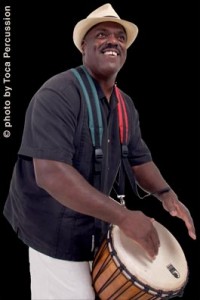Text by Sohrab Saadat Ladjevardi
My first encounter with the djembe was, when I played with Salif Keita and his band for the first at the Blue Note in Tokyo in 2001. Before the show I had no chance to rehearse with him. When Salif called me on stage to join him in one of his songs, I felt so insecure and was so scared. When he started the song I didn’t know what to do about myself. But things instantly changed when I started to play my solo. I could feel instantly that the djembe player was following me. He quickly developed a cool rapport with me. By doing so he gave me confidence in my performance. I could feel that he enjoyed the melodies and noise I created. Eventually we were grooving together, so did the whole band. Salif and the whole band enjoyed my contribution to the song. The audience got excited as well, so when we finished we received a standing ovation. What an experience!!!
 Playing three nights with Salif at the Blue Note made me decide to look for a djembe player for my own band. I searched in the internet for djembe players in Tokyo and found out about an African restaurant in the outskirts of Tokyo which had African live music once a week.
Playing three nights with Salif at the Blue Note made me decide to look for a djembe player for my own band. I searched in the internet for djembe players in Tokyo and found out about an African restaurant in the outskirts of Tokyo which had African live music once a week.
Some weeks later there was a Senegalese music and dance show directed by the Senegalese sabar player Wagane N’Diaye Rose. Before going I thought that the sabar drum is kind of a djembe drum, but when I saw him playing I found out that I was wrong. It’s a different drum but played with the same spirit. Wagane invited me to sit in and wowwwwwwwwww it was great playing with him. I fell in love with him in the same way I did with Salif’s djembe player. A couple of months later he joined my band The Tehran-Dakar Brothers. After moving to New York I had following Senegalese musicians in my band: Mar Gueye (sabar), Masamba Diop (tama or talking drum), Cheikh Tarou B’Baye (sabar), Jean-Marie Collatin-Faye (djembe) and now Michael Wimberly (djembe and drums) who is American.

